Sergio de Castro Figures and lines
Exhibition January 2022
SERGIO DE CASTRO (1922-2012)
Figures and lines
Sergio de Castro was a multi-faceted artist who took an interest in a number of different fields: music, architecture, stained glass, painting, drawing, and more. The genre-breaking artist used various techniques in his work: painting with oil and egg tempera, and working with gouache, ink and pencil. Moreover, his work took on many subjects: still lifes, the studio, landscapes, portraits, and more. Within this multi-faceted body of work, we have chosen to focus on the theme of the human figure in the artist’s work from the first half of the 1950s.
GRID & DOUBLE LINE
After training with the artist Joaquin Torres García, Sergio de Castro developed an artistic vocabulary of his own. He explored many themes through the human figure, in a testament to his creative genius. The art historian Paule-Marie Grand explained: “The gouaches are constructed like canvases with rhythms that are most often linear and vertical. They are vigorous and subtle. They have authority and they testify to a craft worthy of the most meticulous of the old masters. (…) it is at every moment that one must think of the ‘little patch of yellow wall’ that Proust speaks of.” [1]
Sergio de Castro constructed his works on paper on the basis of grids and double lines, an approach we should consider in connection to his training as an architect—as encouraged by his father. It was a geometric period for the artist, marked by the essential role of line and form, which would also foreshadow his great interest in stained glass. The art historian Lydia Harambourg explained: “The independence of Castro, within the pictorial issues that stimulate the Parisian art scene, is accomplished through constant interaction between painting and stained glass. (…) While he opts for a narrative style, any subject for him is above all a visual arts subject. (…) His development of form can only be understood if we compare his painting and his stained glass work, which respectively evoke the two original identities of Sergio de Castro’s art, the constructive and the ornamental. In his constant quest to move from the linear to the pictorial, from writing to colour, gesture is the one element through which everything transpires.“ [2]
LITERARY AND HISTORICAL SOURCES
Sergio de Castro was an erudite artist who referenced literary themes in his work. From mythology and history to the Bible and fables, everything was a source of inspiration. Fantastic characters came to populate the graphic work of Sergio de Castro as mermaids or fauns. As the writer John Russell stated, “In the work of the graphic period there is, on the contrary, a wry and nimble humour in the treatment of the figures. This humour owes something to Klee, and
1 – Paule-Marie Grand, « Sergio de Castro », Le Monde, 1972
2 – Lydia Harambourg, Sergio de Castro, 2006
something also to Torres García, but the quintessence of it, the affectionate mischief of the story-telling, is Castro’s own. When his Jonah gets clear away from the whale, or his idiotic St George gets down to the duty of killing the dragon, the familiar stories come up quite fresh and there is something at once dandified and incisive about the manner of their presentation.” [3]
Sergio de Castro also turned to ancient civilizations as sources of artistic and iconographic inspiration. The Argentine artist was familiar with Inca art—the geometric shapes, almond-shaped eyes and the frontal position of figures undoubtedly marked the artist. The writer Jean Bouret said the following about Sergio de Castro: “To define him in spirit is not easy at all, he has resonances of Maya artists, this need to decompose the moments of an action into rhythms.” [4] Sergio de Castro was also inspired by ancient Egypt. From the simplified style that makes the features so expressive to the admirable balancing of headdresses on angular necks, all of this can be found in his graphic profiles.
Sergio de Castro was a knowledgeable artist who also made references to the history of painting and its classical themes. The woman in the mirror, for example, is an ancient theme that was particularly appreciated during the Renaissance. Following on from Giovanni Bellini and Titian, the theme was later depicted by Pre-Raphaelites such as Dante Gabriel Rossetti, as well as modern artists such as Salvador Dalí, Fernand Léger and Pablo Picasso—a lineage that Sergio de Castro has joined. The art critic Denys Sutton wrote: “His cultivated, determined and pure art, while avoiding that which is only of the concern of the fashion and the pitfalls of the pastiche, expresses a faith and an adherence to the concept of beauty in itself which are all the more original due to their long neglect.” [5]
SERGIO DE CASTRO AND MUSIC
Before becoming a painter, Sergio de Castro was a musician. He studied music from 1933 to 1938 and wrote musical works that were performed in concert in 1940. In 1945, Sergio de Castro moved to Córdoba in Argentina, where he worked as the assistant of the composer Manuel de Falla. He was then appointed as a professor of music history at the new conservatory in La Plata, Argentina. With the help of a grant from the French government, Sergio de Castro moved to Paris in 1949 to complete his musical training. The following year, he joined the music group Zodiaque, which was headed by the composer Maurice Ohana.
Music is very present in his pictorial work. “From his studies as an architect and his training as a musician, Sergio de Castro retains (…) the order and the rhythm, the rigour and the accuracy of tone. (…) In 1951, he carried out two parallel investigations: one focused on drawing, which involved the invention of the double line in his work, the other on painting with his first white paintings. The structure is dominant and very geometric, like the forms that he reduced through simplification and articulated meticulously. In his flat and frontal compositions, he balances the vertical and linear axes (the columns) and disperses the elements (the constellations), like a back and forth between the investigations of Kandinsky and Mondrian.” [6]
3 – Denys Sutton, Sergio de Castro, Matthiesen Gallery exhibition catalog, London, 1958
4 – Jean Bouret « À la découverte de SERGIO de CASTRO », Revue ART, Paris, 16 mars 1951
5 – Denys Sutton, Sergio de Castro, Matthiesen Gallery exhibition catalog, London, 1958
6 – Musée de Saint-Lô, Dany Jeanne, La période de formation et d’expériences (1939-1955), 2006
 Sergio de Castro, 1949. Photo: A. Saderman
Sergio de Castro, 1949. Photo: A. Sadermanon a theme or a pictorial technique, then changed his focus and moved on to something else. This made his work particularly rich. Lydia Harambourg wrote: “While he opts for a narrative style, any subject for him is above all a visual arts subject. While his choice to work in series may give rise to fears of a rupture, this thematic recourse finds profound resonance in the work of the musician-composer (…) as a way of reviving his introspection. As a musical form par excellence, the variation, which he practices as an exercise in artistic investigation, is at the heart of a dialectic that is also based on the religious and the spiritual. The thematic games, the games of styles, are sanctioned by a world of static forms and a world of complementary dynamic forms.” [7]
Lastly, music can also be found in the themes addressed: the pictorial work of Sergio de Castro is strewn with musicians and dancers.
In addition to his work as a musician and painter, Sergio de Castro was also a poet. An unusual profile, the artist naturally looked to other 20th century painter-poets such as Vassily Kandinsky and Paul Klee. Many parallels can be established between the three artists: from their work on colour, line and rhythm, to the importance of travel and music, we can see similarities in their pictorial works. The art critic Denys Sutton confirmed: “Castro has learned a great deal from the ‘poetic’ painters of our century, in particular from Paul Klee; one suspects him to have also been influenced by Kandinsky; it would be logical to assume that an artist who had precise ideas about the relationship between music and painting, as he demonstrated in the Blaue Reiter, might have appealed to him.” [8]
FIGURATION
Sergio de Castro was a figurative painter. After arriving in Paris in 1949, he found himself in the midst of an art scene divided by the abstraction/figuration debate, between lyrical and geometrical abstract artists on one side and figurative painters on the other. In the context of an end to world conflict, the latter often chose a hard style of figuration anchored in a difficult daily reality, such as, for example, Bernard Buffet.
Sergio de Castro, on the other hand, did not engage in this debate, choosing instead to take a figurative path by exploring a variety of themes—always, however, using a colourful and poetic style of painting. This independence, this freedom of spirit, was no doubt made possible by Nicolas de Staël, who provided an alternative with his return to figuration. The role of colour was also very important, while the themes addressed were light: music, sports, etc. Denys Sutton confirmed in 1957: “A young painter can now use a figurative style without seeming old-fashioned, backward, or out of step with the norms of the idiom of his time; he is only trying to fashion a new, contemporary idiom. The person primarily responsible for this break with the dogmatism of the abstract school, which allowed painters to adopt this new approach, was Nicolas de Staël: he played the role of mediator between two seemingly irreconcilable positions. Since de Staël’s untimely death, the innovations he introduced have been taken up by several painters of varying talents. The most notable and gifted of these is Sergio de Castro,
7 – Lydia Harambourg, Sergio de Castro, 2006
8 – Denys Sutton, Apollo, n° 394, Londres, 1957
a young Argentinian painter now living in Paris, who has absorbed in a striking way some of the strengths of de Staël’s contribution without losing any of his own personality; he has completed and upheld the message of his work.”9
Fundamentally figurative, Sergio de Castro was also a portraitist. He depicted his relatives using their faces as a pretext for the expression of colours and lines. In this respect, he is reminiscent of Matisse and Picasso. The art historian André Chastel wrote: “Each one sets the rules of their game at their convenience, considers what they are obsessed with as prodigious, and develops a new temptation. The marvellous, the fantastic and the original abound: as well as ease and credulity. What matters to us, now, is the attempt to contain and gather. It was evident in the work of Nicolas de Staël. With a very different method, and a very Iberian attitude, the same need is manifested in the work of Castro. (…) Castro instinctively joined the small group of painters, like Klee or Vieira da Silva, for whom delight—and the fields it opens up—is indeed ‘the end of art’, but with a general economy of means and a rather particular mode of formulation.” He added: “He has not, therefore, felt challenged by the great contemporary debate on the antinomy of abstract and figurative, object and image. He intends to go forward without making a useless decision; he does not feel that it is necessary. He allows himself all the more willingly to look at the cold structures of Mondrian today, as he did the milky ways of Kandinsky yesterday. He intends not to deprive himself of any assistance.” [10]
Sergio de Castro thus depicted real people from his entourage with great freedom. For example, he portrayed his friend, the ceramist Francine Del Pierre, in a portrait inspired by the shapes and colours of her pieces.
Nourished by multiple influences, pictorial and poetic, ancient and modern, Sergio de Castro offers us a very personal body of work. John Russel confirmed: “His is not an airless, classicizing art: it is a classic art, in which passions are none the less tempestuous for the perfected moderation of their expression. It is modern, without being modernistic; original, without ever striving to appear so; serious, but with never a moment of dullness or emphase, and entirely seductive, without ever using that seduction for vapid or ephemeral ends. Altogether I know of no painter of Sergio de Castro’s age whose work gives the observer so encouraging an idea, not so much of ‘the future of art’, as of the future of the artist as a human being.” [11]
9 – ibid
10 – André Chastel, « Petit portrait de Sergio de Castro », Matthiesen Gallery exhibition catalog, London, 1958
11 – John Russel, « Sergio de Castro », Goya, n° 46, Madrid, 1960
EXHIBITED ARTWORKS

Untitled – 1950
Gouache on paper – 17 x 18 cm / 6.7 x 7.1 in.
Signed and dated “CASTRO 50“ upper left
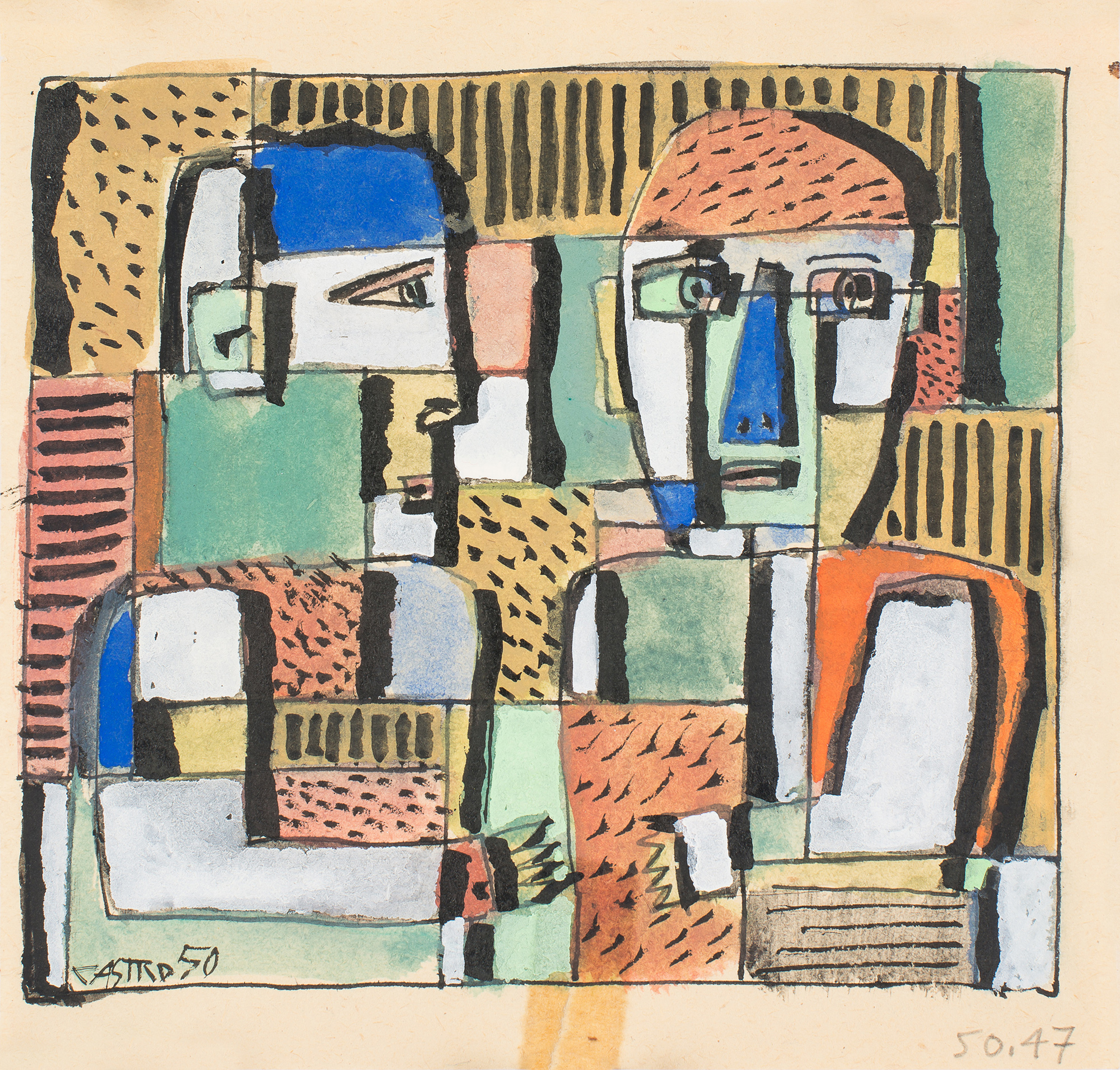
Untitled – 1950
Gouache and ink on paper – 13,5 x 14 cm / 5.3 x 5.5 in.
Signed and dated “CASTRO 50“ lower left

Untitled – 1951
Gouache and ink on tinted paper – 25,5 x 20 cm / 10 x 7.9 in.
Signed and dated “CASTRO 51“ lower right

Untitled – 1951
Gouache and pencil on tinted paper – 28,5 x 21,5 cm / 11.2 x 8.5 in.
Signed “CASTRO“ lower left, numbered “51.67“ lower right

Untitled – 1951
Felt pen on tracing paper – 28,5 x 21,5 cm / 11.2 x 8.5 in.
Signed and numbered “CASTRO 51.71“ upper left
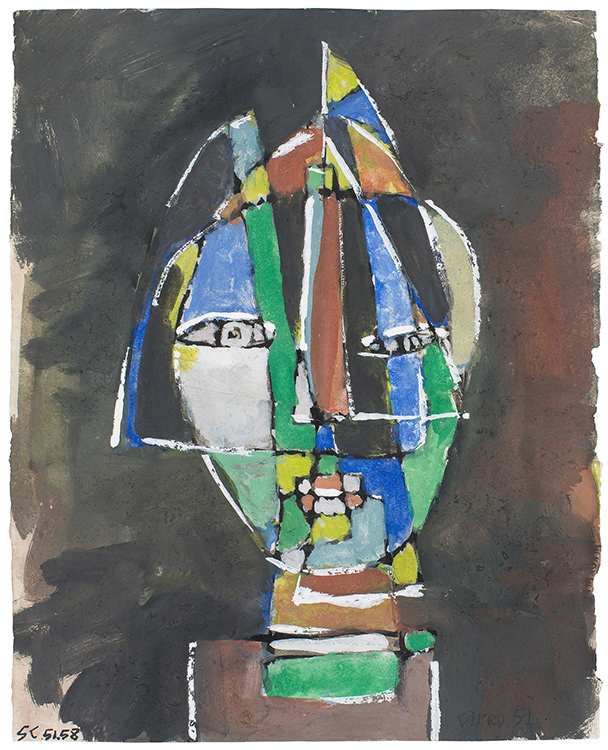
Untitled – 1951
Gouache on paper – 17,5 x 14 cm / 6.9 x 5.5 in.
Inscribed “SC 51.58“ lower left. Signed and dated “CASTRO 51“ lower right

Portrait d’Yvette Quenouille – 1952
Gouache on paper
23 x 16 cm / 9.1 x 6.3 in.»

Portrait de Francine Del Pierre – 1951
Gouache on paper – 60 x 43 cm / 23.6 x 16.9 in.
Signed and dated “CASTRO 51“ lower right
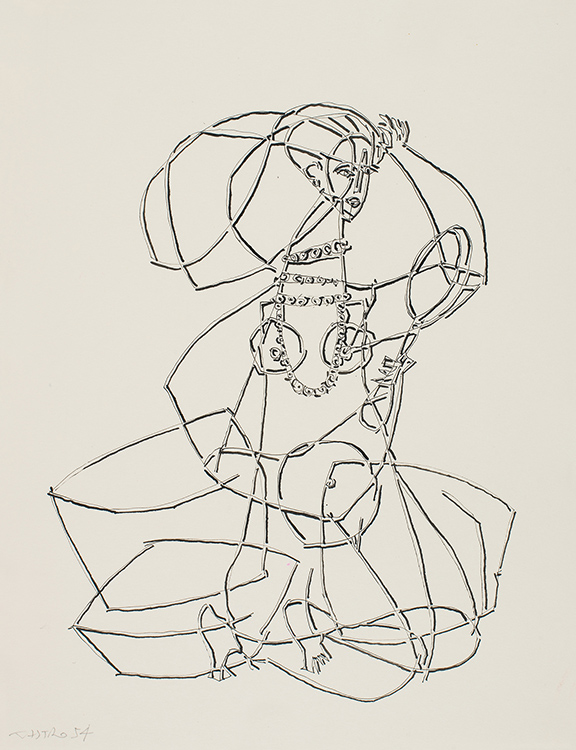
Untitled – 1954
Ink on paper – 27 x 20,5 cm / 10.6 x 8.1 in.
Signed and dated “CASTRO 54“ lower left

Untitled – 1953
Gouache and ink on paper – 44 x 31 cm / 17.3 x 12.2 in.
Signed and dated “Sergio de Castro 53“ upper right

Untitled – 1952
Ink on paper – 36 x 26 cm / 14.2 x 10.2 in.
Signed and dated “Sergio de Castro 52“ lower right

Mujer y paloma – 1952
Gouache and ink on paper – 24 x 31 cm / 9.5 x 12.2 in.
Signed and dated “CASTRO 52“ lower left

Untitled – 1954
Gouache and pencil on paper – 55,5 x 42,5 cm / 21.9 x 16.7 in.
Signed and dated “CASTRO 54“ lower right

Untitled – 1954
Gouache and felt pen on paper – 32 x 23 cm / 12.6 x 9.1 in.
Signed and dated “CASTRO 54“ upper left
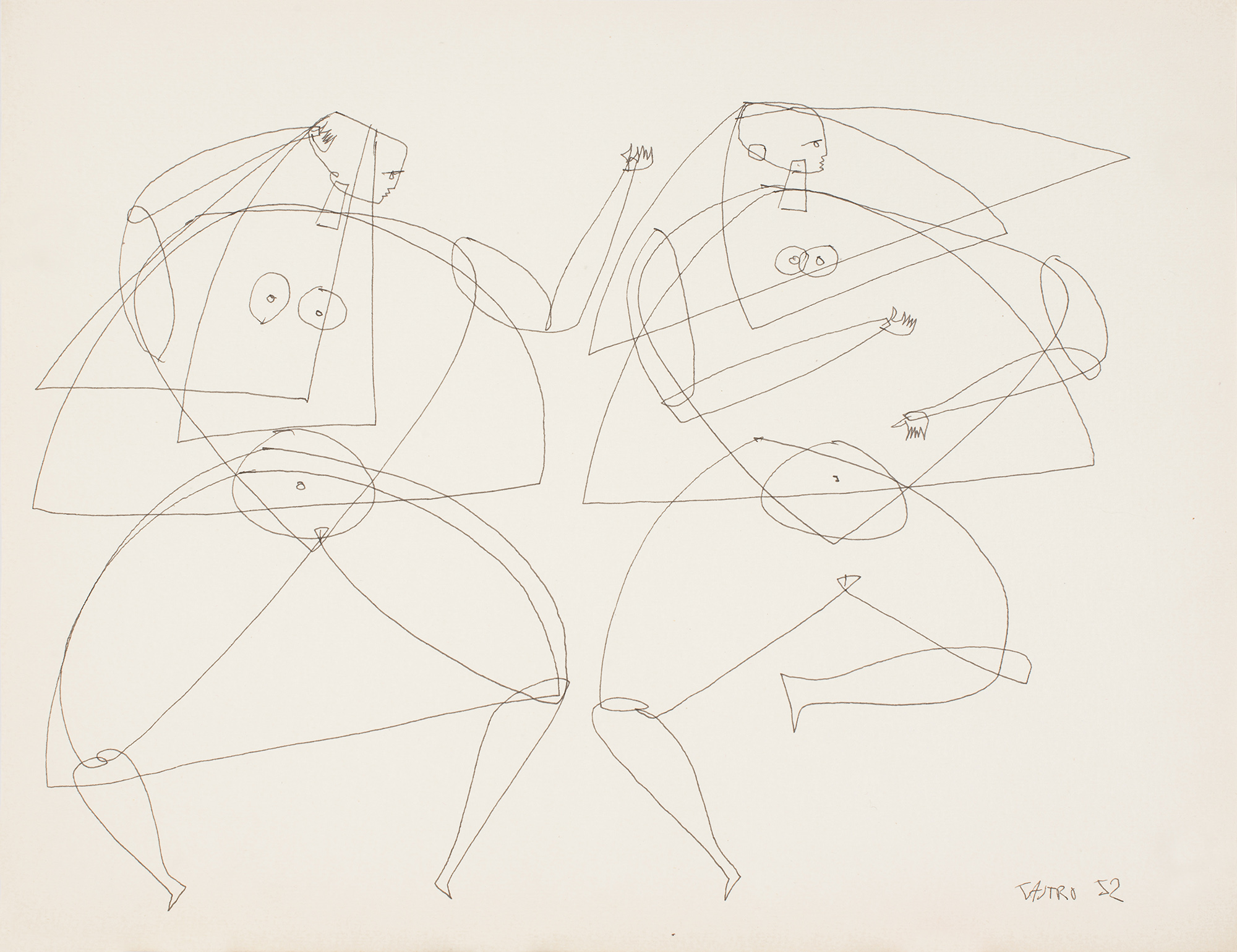
Untitled – 1952
Ink on paper – 24 x 31 cm / 9.5 x 12.2 in.
Signed and dated “CASTRO 52“ lower right

Untitled – 1952
Ink on paper – 24,5 x 31 cm / 9.7 x 12.2 in.
Signed and dated “CASTRO 52“ upper left
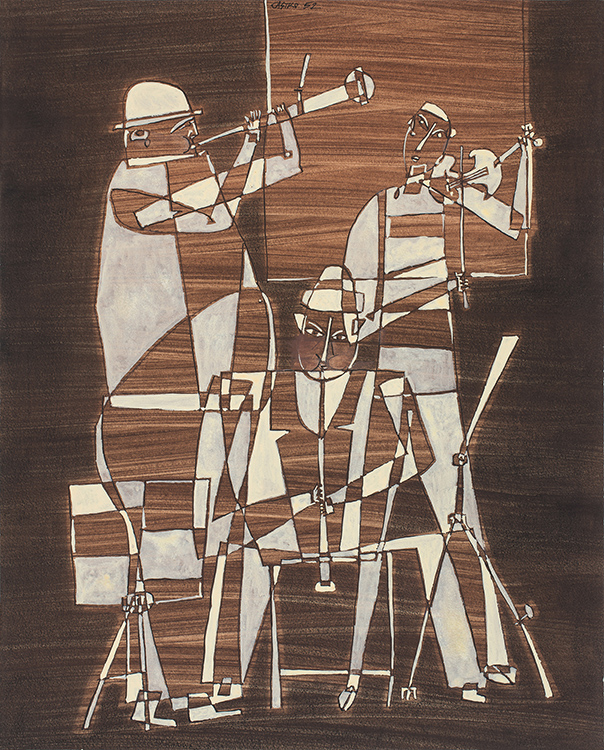
Untitled – 1952
Gouache on paper – 45 x 36 cm / 17.7 x 14.2 in.
Signed and dated “CASTRO 52“ upper center

Voces – 1952
Gouache and ink on tinted paper – 42,5 x 31,5 cm / 16.7 x 12.4 in.
Signed and dated “CASTRO 52“ lower left

Untitled – 1952
Gouache and ink on paper – 36 x 32 cm / 14.2 x 12.6 in.
Signed and dated “CASTRO 52“ lower right

Untitled – 1951
Ink on paper – 34 x 25,5 cm / 13.4 x 10 in.
Signed and dated “Sergio de Castro 51“ lower right
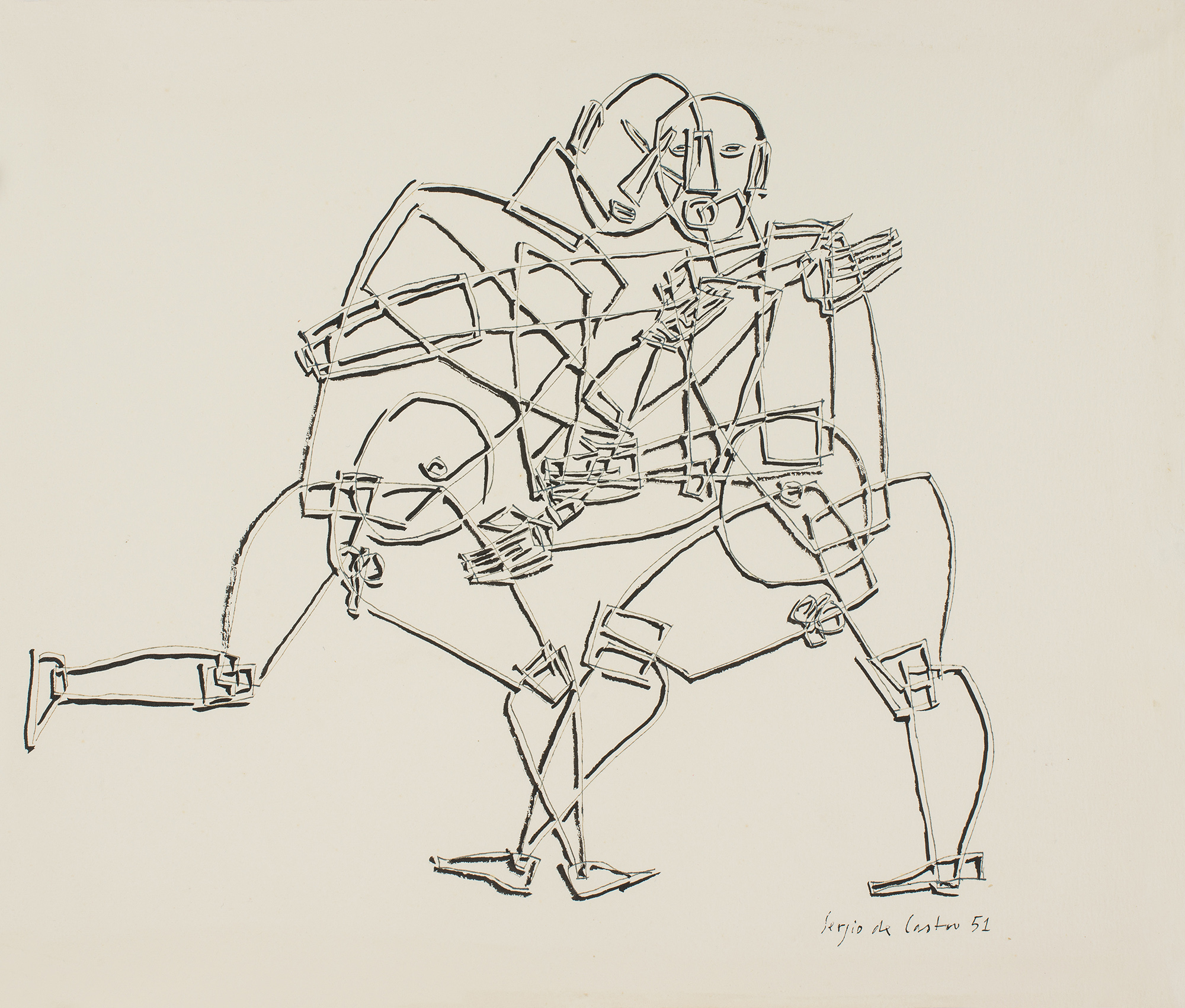
Luchadores – 1951
Ink on paper – 26,5 x 30,5 cm / 10.4 x 12 in.
Signed and dated “Sergio de Castro 51“ lower right
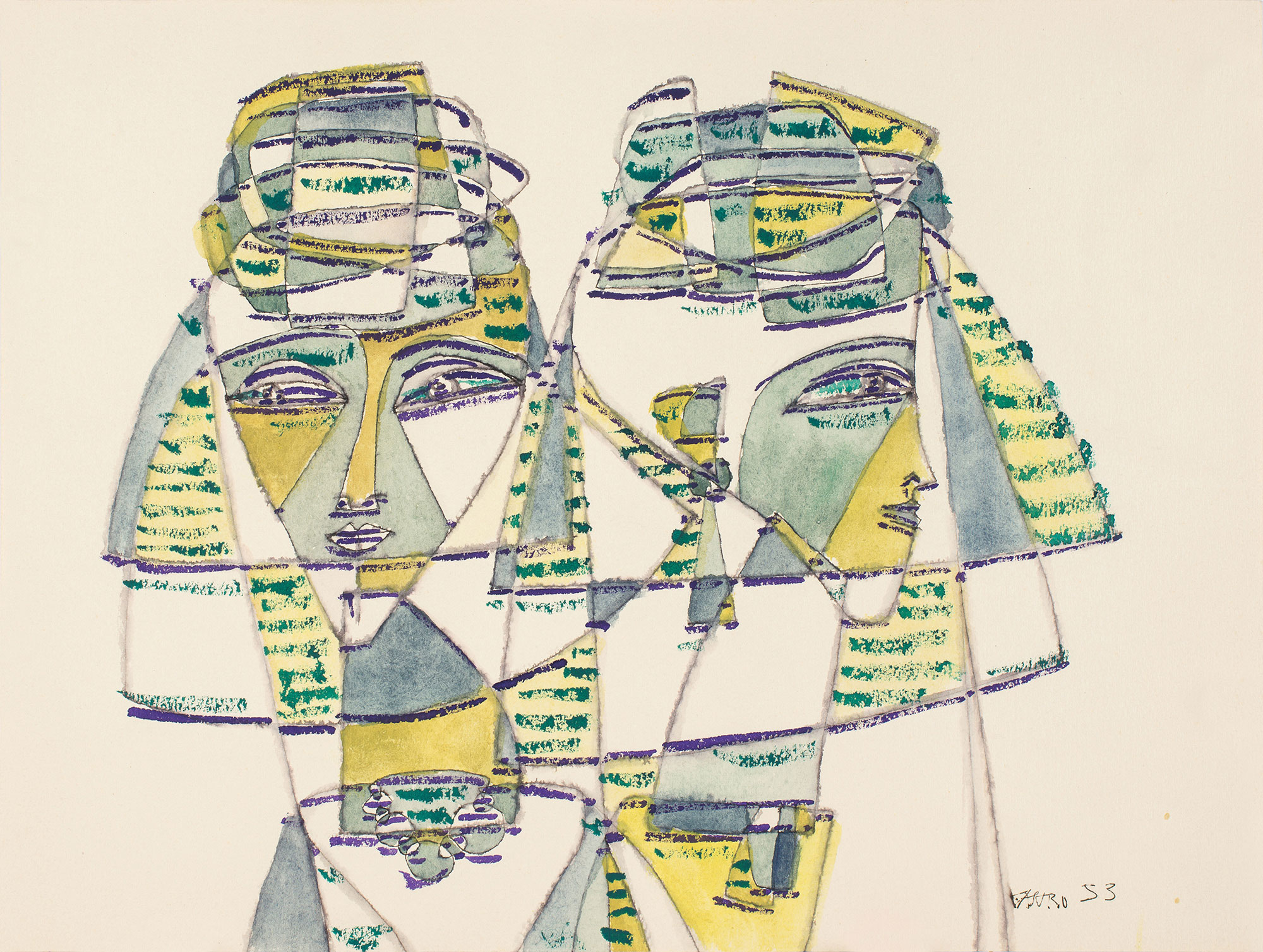
Untitled – 1953
Gouache on paper – 26 x 35 cm / 10.2 x 13.8 in.
Signed and dated “CASTRO 53“ lower right

Untitled – 1953
Gouache and ink on paper – 42 x 36 cm / 16.5 x 14.2 in.
Signed and dated “CASTRO 53“ lower right

Untitled – 1953
Ink and gouache on paper – 35 x 26 cm / 13.8 x 10.2 in.
Signed and dated “Sergio de Castro 53“ lower right

Untitled – 1954
Gouache and felt pen on paper – 31 x 52 cm / 12.2 x 20.5 in.
Signed and numbered “CASTRO 2b.2.54“ upper left

Duo – 1953
Ink on tinted paper – 61 x 50 cm / 24 x 19.7 in.
Signed and dated “Sergio de Castro 53“ upper right

Les parques – 1953
Ink on tinted paper – 50 x 65 cm / 19.7 x 25.6 in.
Signed and dated “CASTRO 53“ lower left

Untitled – 1951
Gouache and ink on paper – 20,5 x 17 cm / 8.1 x 6.7 in.
Signed and dated “CASTRO 51“ upper right

Untitled – 1953
Ink and gouache on paper – 37 x 30 cm / 14.6 x 11.8 in.
Signed and numbered “Sergio de Castro 9.8.53“ upper right

Untitled – 1953
Gouache on paper laid down on canvas – 44,5 x 37 cm / 17.5 x 14.6 in.
Signed and dated “CASTRO 53“ lower right. Signed and numbered “CASTRO 53.53“ on reverse on the stretcher»

Untitled – 1953
Gouache and ink on paper – 31 x 44 cm / 12.2 x 17.3 in.
Signed and dated “CASTRO 53“ upper left. Signed and numbered “CASTRO 53.123“ lower left

Untitled – 1952
Gouache and ink on paper – 20 x 22 cm / 7.9 x 8.7 in.
Signed and numbered “CASTRO 52./48“ lower right

Untitled – 1954
Gouache and felt pen on paper – 43,5 x 31 cm / 17.1 x 12.2 in.
Signed and numbered “CASTRO 19.2.54“ lower right

Untitled – 1953
Gouache and ink on paper – 31 x 44 cm / 12.2 x 17.3 in.
Signed and numbered “CASTRO 29.9.53“ lower right

Untitled – 1953
Gouache on paper laid down on canvas – 44,5 x 36 cm / 17.5 x 14.2 in.
Signed and numbered “CASTRO 53.78“ lower left. Signed and numbered “CASTRO 53.78“ on reverse

Femmes sous la pluie – 1953
Gouache on paper – 52,5 x 75 cm / 20.7 x 29.5 in.
Signed and dated “CASTRO 53“ upper left
BIOGRAPHY
SERGIO DE CASTRO’S EARLY LIFE AND ARTISTIC TRAINING
Born on 15 September 1922 in Buenos Aires, Sergio de Castro spent his childhood between Lausanne, Switzerland, and Turin, Italy. The young Sergio learned Spanish in Uruguay and began writing his first poems. In 1939, at the age of 17, Sergio de Castro walked along the Uruguayan coast by himself, travelling from Montevideo to Brazil. It was then that he met Joaquin Torres-Garcia (1874-1949), an artist whose teaching would play a decisive role in the Argentine’s development. At his father’s request, Sergio de Castro spent a year studying architecture; meanwhile, he was already active as a composer and also began to explore drawing and painting.
SERGIO DE CASTRO AND MUSIC
A multi-talented and precocious artist, Sergio de Castro also expressed himself through music, which he studied from 1933 to 1938. He wrote musical works that were performed in concert for the first time in 1940 at the University of Montevideo. It was then that he was spotted by the conductor Wilhelm Furtwängler and the composer Alberto Ginastera.
In 1945, Sergio de Castro moved to Córdoba in Argentina, where he worked as the assistant of the composer Manuel de Falla for 18 months, until the latter’s death. In 1947, the actress Cecilia Ingenieros—a student of the dancer Martha Graham—staged a ballet at the Teatro del Pueblo in Buenos Aires based on Sergio de Castro’s musical work Doce variationes breves. Two years later, he was appointed as a professor of music history at the new conservatory in La Plata, Argentina. With the help of a grant from the French government, Sergio de Castro moved to Paris in 1949 to complete his musical training. The following year, he joined the music group Zodiaque, which was headed by the composer Maurice Ohana.
Although Sergio de Castro eventually put music aside to devote himself to painting, he was still regularly invited to musical events. The Maillon cultural center (in Strasbourg), for example, exhibited a series of works during a musical week dedicated to Maurice Ohana and the music of the Hesperides in 1986. In the same year, Sergio de Castro was invited to the Festival des Musiques Actuelles Nice Côte d’Azur (the ‘MANCA’ Festival). In 1992, Silvina Luz Mansilla published the first volume of her Diccionario De La Musica Espanola E Hispanoamericana in Spain, which included a text on the musical work of Sergio de Castro.
THE ARTIST SERGIO DE CASTRO IN ARGENTINA
Sergio de Castro settled in Buenos Aires in 1942 and had his first exhibition at the Ateneo de Montevideo. His work was also exhibited at the Torres Garcia studio—an organisation founded in 1943 by the artist Joaquín Torres-García to enable young artists to access training. The following year, Sergio de Castro, Joaquín Torres-García and his students worked together on a series of murals for the Martirené Pavilion of the Saint Bois Hospital in Montevideo. Sergio de Castro took part in the group exhibition Pintura uruguaya, which was held at Comte Gallery in Buenos Aires, in the same year. In 1946, he travelled to the northwest of Argentina and the south of Peru to study pre-Columbian art, accompanied by the painters Gonzalo Fonseca, Julio Alpuy and Jonio Montiel.Sergio de Castro moved back to Buenos Aires in 1947. The following year, he was presented at the Salon of the Santa Fe Museum of Fine Arts. His works were also presented at the Viao Gallery, the Bonino Gallery and the Van Riel Gallery. In 1987, the Museo de Arte Moderno in Buenos Aires organised a retrospective dedicated to the artist’s work, which presented some one hundred works.
THE ARTIST SERGIO DE CASTRO IN FRANCE
Sergio de Castro was awarded a grant by the French government in 1949 and settled permanently in Paris in November of the same year. In 1950, the artist was hospitalised due to severe asthma attacks at the Necker Hospital in Paris, where he spent much time drawing. The following year, he painted a monumental work in oil on canvas measuring 160 x 300 cm, which he called El Puerto. From then on, he retired from his activities as a composer to devote himself to painting and stained glass work. In 1952, Sergio de Castro had his first solo exhibition in Paris, at the Galerie Jeanne Castel, where he presented a collection of still lifes. Starting to paint with egg tempera, he went on to exhibit his works at the Galerie Pierre. He was also represented in the French capital by the Galerie Max Kaganovich, the Galerie Rive-Gauche and the Galerie Charpentier.
Sergio de Castro met many artists—such as Picasso, whom he met in Paris and in the South of France where he went in summer—and exhibited alongside Bazaine, Picasso, Lanskoy and de Staël. In 1953, Sergio de Castro set up his studio at 16 bis Rue du Saint-Gothard in Paris’ 14th arrondissement, where he began work on his large linear compositions.
The artist became a naturalised French citizen in 1979 and was made a Chevalier of the Ordre des Arts et Lettres and then an Officer of the Ordre des Arts et Lettres in 1999. In 2003, he made preparations for a donation of works to the Museum of Saint-Lô (Normandy) with the curator Michel Carduner. In 2006, the entire donation (comprising 220 works) was presented to the Musée des Beaux-Arts et d’Histoire in Saint-Lô.
STAINED GLASS IN SERGIO DE CASTRO’S WORK
Sergio de Castro was a multi-faceted artist. In addition to paintings and music, he also created a number of stained glass works. In 1956, Sergio de Castro began work on a monumental stained-glass work entitled La Création du Monde [The Creation of the World]. Measuring 6 x 20 metres, the work was designed for the church of the Benedictine Monastery of Saint-Sacrement in Couvrechef-la-Folie, near Caen—a building rebuilt after the war. In 1968, he created a 4.5 x 17 metre stained glass window for the 1st Lutheran Dietrich-Bonhoeffer-Kirche in Hamburg. In 1979, Sergio de Castro began work on the composition of five stained glass windows for the Collegiate Church of Notre-Dame de l’Assomption in Romont, Fribourg (Switzerland), which were installed two years later. In 1980, he was invited to the 1st Salon of Stained Glass at the International Stained-Glass Centre in Chartres, France, where he presented Résurrection, a stained glass work measuring 4.2 x 1.2 metres.
The 1st Festival of Contemporary Sacred Art presented an exhibition dedicated to Sergio de Castro with 72 works from 1948-1978 on religious subjects at the Musée Diocésain d’Art Religieux in 1988. In the book Les Trésors de la France, published in 1988, the author Michel Parent wrote two texts in the section on “Contemporary Stained Glass”, entitled Audincourt et Fernand Léger and La Folie-Couvrechef et Sergio de Castro. In 2008, the Saint-Lô Museum presented the exhibition 50 ans d’Art du Vitrail autour de Sergio de Castro and then inaugurated the stained glass windows Abécédaire and Chiffres in 2012.
INTERNATIONAL RECOGNITION FOR THE ARTIST SERGIO DE CASTRO
Several retrospectives have been devoted to the artist in many countries. Sergio de Castro went to the United Kingdom for the first time in 1957 and had his first solo exhibition in London at the Matthiesen Gallery the following year. In 1962, the editor of Apollo magazine
Denys Sutton, organised an exhibition of his work at the Leicester Gallery before publishing a monograph on Sergio de Castro in 1964. A solo exhibition of the artist’s work entitled Homages and Variations was presented at the French Institute in London in 1987, exhibiting 30 works from 1957-1975 inspired by Dürer, Holbein, El Greco and Vermeer.
Sergio de Castro also had strong ties to Switzerland, his childhood home. His work was presented in 1958 in Lucerne at the Kunst-Museum in a group exhibition entitled Junge Maler aus Deutschland und Frankreich. In 1966, the artist was presented in a major retrospective exhibition at the Musée d’Art et d’Histoire in Fribourg, where 103 of the artist’s works were shown. A solo exhibition of Sergio de Castro’s work was organised at the Castle of Gruyères in 2008.
Sergio de Castro’s work also became well known in Germany, where it was featured at the Documenta II exhibition in Kassel in 1959. Hans Platte organised the first retrospective of Sergio de Castro’s work in an exhibition comprising 110 works at the Kunstverein in Hamburg in 1965. The following year, the exhibition Variationnen über ein Thema organised by Thomas Grochowiak at the Städtische Kunsthalle in Recklinghausen presented eight variations on Le Greco by Sergio de Castro. The exhibition would include works by Francis Bacon, Paul Cézanne, Henri Matisse and Pablo Picasso, among others.
In Italy, Sergio de Castro participated in the Biennale Francia-Italia at the Palazzo delle Arte al Valentino in Turin in 1956. The gallery owner Bruno Lorenzelli then presented 40 works by the artist in Milan in 1963 and in Bergamo in 1964. In 1980, Sergio de Castro participated in the 39th Venice Biennale, where he presented large-format works from the 1970s in the Argentine Pavilion.
Sergio de Castro was also exhibited in the United States. In 1960, the artist won the fourth prize in the Fifth International Hallmark Art Award alongside the painters Alechinsky, Marsicano and Charchoune.. In 1995, he participated in a group exhibition at the Chac-Mool Gallery in Los Angeles.
Sergio de Castro died in Paris on 31 December 2012. He was laid to rest in the Montparnasse cemetery.
SELECTED COLLECTIONS
Amsterdam (the Netherlands), Peter Stuyvesant Foundation
Auxerre (France), Saint-Georges-sur-Baulche, the Library of Yonne
Bern (Switzerland), Swiss National Library, Georges Borgeaud Collection
Bremen (Germany), Kunsthalle
Caen (France), Benedictine Monastery of Saint-Sacrement in Couvrechef-la-Folie
Hamburg (Germany), Dietrich-Bonhoeffer-Kirche
La Défense, Paris (France), Atochem company entrance hall
Luxembourg City (Luxembourg), National Museum of History and Art
Montevideo (Uruguay), Martirené Pavilion of the Saint-Bois Hospital
Paris, France, Centre National des Arts Plastiques
Paris, Fonds National d’Art Contemporain (FNAC)
Romont, Fribourg (Switzerland), Collegiate Church of Notre-Dame de l’Assomption
Saint-Lô (France), Musée des Beaux-Arts
Sélestat (France), Fonds Régional d’Art Contemporain (FRAC) Alsace
Vienna, MUMOK
Vienna, Museum of the Twentieth Century
SELECTED EXHIBITIONS
Taller Torres-Garcia, group exhibition, Ateneo de Montevideo, Montevideo, every year from 1942 to 1949
Pintura Uraguaya, group exhibition, Comte Gallery, Buenos Aires, 1944
Augusto y Horacio Torres-Garcia, Sergio de Castro, Jonio Montiel, group exhibition, Galeria Viau, Buenos Aires, 1947
Donation de los Santos, group exhibition, Museo Provencial de Bellas Artes, Sante Fe, 1948
Concours Air France, group exhibition, Galerie des Beaux-Arts, Paris, 1951
Solo exhibition, Galerie Jeanne Castel, Paris, 1952
Solo exhibitions, Bonino Gallery, Buenos Aires, 1952, 1956
Prix Buhrle, group exhibition, Galerie Kaganovitch, Paris, 1953
Solo exhibition, Galerie Pierre (Pierre Loeb), Paris, 1954
Solo exhibition, Van Riel Gallery, Buenos Aires, 1955
Dibujos de artistas argentinos, group exhibition, Bonino Gallery, Buenos Aires, 1955
Peintres contemporains présentés par René de Soliers, group exhibition, Centre Culturel International, Cerisy-La-Salle, 1955
Solo exhibitions, Galerie Charpentier, Paris, 1955, 1956, 1957, 1958, 1960, 1961
Solo exhibitions, Galerie Rive-gauche, Paris, 1955, 1958
Solo exhibition, Galerie Rive-Gauche, Paris, 1956
Art Contemporain, group exhibition, Château d’Harcourt, Chauvigny, 1956
Sélectionnés de la Critique, group exhibition, Galerie Saint-Placide, Paris, 1956
Biennale Francia-Italia, Palazzo delle Arti al Valentino, Turin, 1957, 1959
Junge maler aus Deutschland und Frankreich, Kunstmuseum, Luzern, 1958
Solo exhibitions, Matthiesen Gallery, London, 1958, 1961
Group exhibition, John Moore Foundation, Walker Art Gallery, Liverpool, 1959
Documenta II, Kassel, 1959
Peintres et Sculpteurs Argentins, group exhibition, Comité France-Amérique, Grand Palais, Paris, 1959
Recent Acquisitions, group exhibition, Arts Council, London, 1959
5th International Hallmark Art Award, Wildenstein Gallery, New York, 1960
Group exhibition, Sesquicentenario, Museo Nacional de Bellas Artes, Buenos Aires, 1960
Art Sacré, group exhibition, Musée d’Art Moderne de Paris, Paris, 1960
Arte Argentina Contemporanea, group exhibition, Museu de Arte Moderna, Rio de Janeiro, 1960
Arte Argentina Contemporanea, Museu de Arte Moderna, Rio de Janeiro, 1961
Group exhibitions, Leicester Gallery, London, 1962, 1963
Solo exhibitions, Galeria Lorenzelli, Milan, 1963, 1964
Art Argentin actuel, Musée d’Art Moderne de Paris, Paris, 1963
Solo exhibition, Bettie Thommen Gallery, Basel, 1964
Retrospective, Kunsteverein (110 works from 1955 to 1965), Hamburg, 1965
Art Contemporain, Palazzo Strozzi, Florence, 1965
Artes Visuales I, Museo Eduardo Sivori, Buenos Aires, 1965
Natures-Mortes, group exhibition, Obere Zaune Gallery, Zurich, 1965
Variationen über ein Thema, Städtische Kunsthalle, Recklinghausen, 1966
Retrospective, Musée d’Art et d’Histoire (103 works from 1955 to 1966), Fribourg, 1966
Von Bauhaus bis zum Gegenwart, Kunsthalle, Hamburg, 1967
Zauberdes Lichtes, Städischeee Kunsthalle, Recklinghausen, 1967
De Lautrec à Matthieu, Musée d’Art et d’Histoire, Fribourg, 1968
Touring retrospective (45 works from 1961 to 1966), the Kunstforening in Holstebrö, th Kunstforening in Oslo, and the Kunstindustrimuseet in Copenhagen, 1970
Racolta Pomini, group exhibition, Galeria Il Milione, Milan, 1970
Castro Landscape of Light, solo exhibition, Wildenstein Gallery, London, 1972
Solo exhibition, Galerie Jacob, Paris, 1972, 1974
Solo exhibition, Château de Ville-d’Avray, 1973
Salon des Réalités Nouvelles, Paris, 1973, 1974
Group exhibitions, Galerie Jacob, Paris, 1973, 1996
Solo exhibition, Galerie Monique Delcourt, Valenciennes, 1974
Art Fair, Düsseldorf, 1974
Solo exhibition, French Cultural Centre, Luxembourg, 1975
Touring retrospective (91 works from 1965 to 1975), the Kunsthalle in Bremen, the Tempelhof in Berlin and the Kunstamt (Berlin Festival), 1975
Retrospective (68 works from 1956 to 1966), Musée des Beaux-Arts, Caen, 1975-76
Signe du Sacré au XXe siècle, Church of Saint-Philibert, Dijon, 1977
Typographie-Écritures, group exhibition, Maison de la Culture, Rennes, 1978
Group exhibition, FRAC Alsace, Strasbourg, 1978
Le Regard du Peintre, group exhibition, Centre Georges Pompidou, Paris, 1978-79
Solo exhibition, Galerie Valmay, Paris, 1979
Tribute to Pierre Loeb, Musée d’Art Moderne de Paris, Paris, 1979
1er Salon du Vitrail, International Stained-Glass Centre, Chartres, 1980
Solo exhibition, “Syn-Art” Association, Paris, 1980
Retrospective (12 large-format works from the 1970s), XXXIX Biennale, Argentine Pavilion, Venice, 1980
Retrospective (100 works from 1940 to 1974), Museo de Arte Moderno, Buenos Aires, 1987
Sergio de Castro à Atochem, solo exhibition, La Défense, Paris, 1987
Solo exhibition, French Institute, London, 1987
Solo exhibitions, Galerie des Ambassades, Paris, 1988, 1989
Solo exhibitions, Galerie Galarté, Paris, 1988, 1995
Retrospective (religious subjects 1948-1978), 1st Festival of Contemporary Sacred Art, Musée Diocésain d’Art Religieux, Bayeux, 1988
Retrospective (48 works from 1972 to 1978), Town Hall, Sochaux, 1991
Castro donation, solo exhibition, Vitromusée Romont, Swiss Museum of Stained Glass, Romont, 1991-92
Renaissance d’une Ville, Normandy Museum, Caen, 1994
Artistas latinoamaricanos en sus estudio, group exhibition, Museo Rufino Tamayo, Mexico, 1994
Group exhibition, Chac Mool Gallery, Los Angeles, 1995-96
Solo exhibition, Galería Sur, Punta del Este (Uruguay), 1998
Salon d’Automne, Paris, 1999
Torres-Garcia et ses disciples, group exhibition, Galerie Ileana Bouboulis, Paris, 2002
Castro donation, solo exhibition, Saint-Lô Museum, Saint-Lô, 2006-07
Solo exhibition, Château de Gruyère (Switzerland), 2008
50 ans de vitrail autour de Sergio de Castro, group exhibition, Saint-Lô Museum, Saint-Lô, 2008-09
Solo exhibition, Museo Gurvich, Montevideo, 2009
Francine Del Pierre et Sergio de Castro, group exhibition, Francine Del Pierre and Fance Franck Studio, Paris, 2010
Mujeres esculturas – Varones pintores, group exhibition, Galerie Argentine, Paris, 2013
Hommage à Sergio de Castro, group exhibition, Galerie Orsay, Paris, 2013
Rayuela, el Parîs de Cortazar, group exhibition, Institut Cervantes, Paris, 2013
De l’Impressionnisme à l’abstraction. Festival Normandie Impressionniste, Musée des Beaux-Arts, Saint-Lô, 2013
Hommage à Jacques Thuillier, un historien d’art à Nevers, group exhibition, Musée de la Faïence et Médiathèque, Nevers, 2014
Otros cielos, group exhibition, Museo de Bellas Artes, Buenos Aires, 2014
Le vitrail contemporain de 1945 à nos jours, group exhibition, Cité de l’Architecture et du Patrimoine, Paris, 2015
BIBLIOGRAPHY (SELECTION)
Jean Bouret, « À la découverte de Sergio de Castro », Art Paris, 1951
Pierre Descargues, « Sergio de Castro, 2 visages ? », Les Lettres Françaises, Paris, 1952
Julio E Payro, Sergio de Castro, Catalogue de l’exposition de la Galeria Bonino, Buenos Aires, 1952
Franck Elgar Carrefour, Sergio de Castro, 1954
André Chastel, « Un jeune peintre Sergio de Castro », Le Monde, 1954
Jean Bouret, « Les Constellations de Castro », Franc-Tireur, Paris, 1954
René de Solier, « Sergio de Castro », Nouvelle Revue Française, 1956
Cordoba-Iturburu, « Personnalité et raffinement chez Sergio de Castro », El Hogar, Buenos Aires, 1956
Mujica Lainez, « El refinamiento de Sergio de Castro », La Nacion, Buenos Aires, 1956
Denys Sutton, « Sergio de Castro », Apollo, Londres, N°394, décembre 1957
Denys Sutton, Sergio de Castro, Musée de Poche, Edition Fall, 1964
Hans Platte, « Sergio de Castro », catalogue de l’exposition Sergio de Castro 1955-1965, Kunstverein de Hambourg, 1965
Arnold Kohler, « L’univers particulier de Sergio de Castro », La Tribune de Genève, 1966
Denys Sutton, « Landscape of Light », catalogue de l’exposition Sergio de Castro, Landscape of light, Galerie Wildenstein, Londres, 1972
Claude Esteban, « Cosa mentale », catalogue de l’exposition Sergio de Castro, Galerie Jacob, Paris, 1972
Guy Weelen, Ceci regarde la peinture, catalogue d’exposition, Galerie Jacob, Paris, 1974
Antonio Bonet, « Correa Dualidad y Unitad en la obra de Sergio de Castro », Coloquio N° 21, Lisbonne, Fondation Calouste Gulbenkian, 1975
Gunther Busch, Rétrospective Sergio de Castro, 1965 – 1975, catalogue d’exposition, Kunsthalle, Brême, 1975
Hans Platte, « Sergio de Castro », catalogue de l’exposition Sergio de Castro, Musée de Caen, 1975-76
Collectif sous la direction Michel Laclotte, Petit Larousse de la Peinture, 1979
Jean-Marie Dunoyer, « Forme : Permanence et métamorphose du visible », Le Monde, 1979
Lydia Harambourg, L’École de Paris 1945-1965 Dictionnaire des peintres, Éditions Ides et Calendes, 1983
Georges Borgeaud, « L’oeuvre de Sergio de Castro », Revue Lyra, N°250/251, Buenos Aires, 1983
Jacques Thuillier, Les Prophètes, Editiones El Viso, 1984
Etienne Chatton, Nouveaux signes du sacré, Coédition Loisir et Pédagogie, Lausanne, Fragnière, Fribourg, 1986
Denis Lavalle, « Sergio de Castro à Bayeux », catalogue de l’exposition Sergio de Castro, sujets religieux 1948 – 1978, 1er Festival d’Art sacré contemporain de Bayeux, 1988
Dora Vallier, « L’oeil écoute », catalogue de l’exposition Sergio de Castro, Natures – Mortes 1958- 1965, Galerie des Ambassades, Paris, 1988
Jean Dominique Rey, « L’atelier du Saint-Gothard », catalogue de l’exposition Sergio de Castro, Les Ateliers 1958 – 1969, Galerie des Ambassades, Paris, 1989
« Entretien de Jean-Dominique Rey avec Sergio de Castro », exposition Sergio de Castro 1972 – 1978, Hôtel de Ville de Sochaux, 1991
Roger Munier, « TERRE ARDENTE », Voir Paris, Deyrolle Éditeur, 1993
Marie-Pierre Colle, « Corcuera Sergio de Castro », Artistas latinos-americanos en sus studios, Noriega Editores, Mexico, 1994
Jacques Thuillier, Histoire de l’Art, Flammarion, 2002
Collectif, Sergio de Castro Soixante ans de création 1944 – 2004, Éditions Somogy et Musée des Beaux-Arts de Saint-Lô, 2006
Lydia Harambourg, « SERGIO DE CASTRO », textes rassemblés autour de J. Thuillier, Édition Somogy, 2006
Collectif, Sergio de Castro, catalogue d’exposition, Musée de Saint-Lô, 2007
Silvia Listur, Sergio de Castro, catalogue exposition, Museo Gurvich, Montevideo, 2009
Christina Rossi, « Sergio de Castro », Revue Pagina 12, Montevideo, 2009
Gianni Burattoni, « De la peinture retrouvée à la peinture transformée », exposition Francine Del Pierre, Sergio de Castro, Atelier Del Pierre- Franck, Paris, 2010
Michel Hérold, Véronique David (dir.), Vitrail Ve – XXIe siècle, Paris, Centre des Monuments Nationaux, Éditions du Patrimoine, 2014

Sergio de Castro, 1958. Photo: M. Planes

Sergio de Castro à Cordoba, 1947
Galerie Diane de Polignac
2 bis, rue de Gribeauval – 75007 Paris
www.dianedepolignac.com
Textes – texts: Mathilde Gubanski
Traduction – translation: Lucy Johnston & Jane McAvock
© OEuvres : ADAGP, Paris, 2022
Photographies des oeuvres : Droits réservés
© Artworks: ADAGP, Paris, 2022
Photographs of the works: Reserved rights
© Galerie Diane de Polignac, 2022
